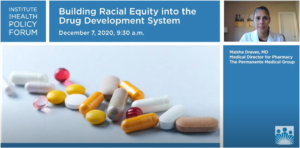On December 7, 2020, the Kaiser Permanente Institute for Health Policy hosted the first of a 2-part virtual forum examining racial equity in the drug development system, including during initial investments and research, patent and regulatory processes, supplier and physician relationships, and distribution to patients. This webinar explored racial inequities in drug investment and research and identified opportunities for improvement in the future. The second webinar on March 1 will focus on equity in clinical trials, access, and affordability.

During the first Institute for Health Policy forum, Maisha Draves, MD, brought the impact of structural racism in the drug development and distribution system into stark focus. She reminded us that it’s likely somewhere, a young white patient with cystic fibrosis is at home with his family because of a recent breakthrough in treatment. At the same time, because of disparities in research funding and a raging pandemic, a young Black patient somewhere is lying in the hospital with sickle cell disease, alone.
Both cystic fibrosis and sickle cell disease are inherited and wreak havoc on the body. But research into cystic fibrosis, which affects one-third the number of people that sickle cell disease affects, has historically received 11 times more funding on a per-patient basis (and 75 times more from philanthropic foundations). One fact distinguishes the 2 diseases: Most people who have sickle cell disease are Black.
This is what structural racism looks like in our drug development and distribution system. In a million subtle and not-so-subtle ways, Black, Latinx, and other people of color are at a structural disadvantage when it comes to their health. Structural racism affects many aspects of the drug development system, including which research gets funded, who gets awarded a patent, and who is included in clinical trials.
I was delighted to discuss solutions to these and other systemic inequities with Dr. Draves; Stanford Medicine’s Hannah Valantine, MD (former head of scientific diversity at the National Institutes of Health); neglected disease expert Rojelio Mejia, MD; and Kapor Capital partner Uriri Onovakpuri.
While we all bring a different lens to this work, some common themes emerged from this important and timely conversation.
One was the need for more institutional accountability. Despite an increasing focus on organizational diversity and inclusion initiatives, structural racism continues to be a barrier for Black, Latinx, and other people of color to thrive within the drug development ecosystem. A first step in achieving progress is for these initiatives to be measured, monitored, and tied to institutional systems of reward — incentivizing behaviors and decisions that advance equity. Holding leaders accountable for investment in, and leadership of, scientists, scholars, investors, and other professionals of color within the system will help direct research and funding into diseases that disproportionately affect people of color.
The drug development system is uniquely out of balance, lacking meaningful and inclusive public participation but heavily shaped by corporate and market interests. Profit projections disproportionately influence how research dollars are allocated and how medicines are priced. The metric for a drugmaker’s performance is the direction of its stock price, which is driven not by public health impact but by the potential for investor returns.
For example, neglected tropical diseases such as toxocariasis and Chagas affect 12 million Americans, but research around them remains chronically underfunded. The market doesn’t incentivize research in these areas because the diseases generally affect poor people, most of whom are Black and Latinx.
We need to build bigger tables across the drug development system and add more seats, so that a broader range of perspectives and experiences are integrated into decision-making.
The consequences of failing to do so are real. For example, Black children are 4 to 5 times more likely to die from asthma than white children. Albuterol, the most commonly used inhaler in the country, is not as effective for Black children — a problem that has been shamefully understudied. Our market-driven approach to drug development has consistently failed to address these disparities.
Better representation across the drug development system — in the pharmaceutical industry, at the National Institutes of Health, in the investment field — is a first step toward the more fundamental work of constructing a system for developing and distributing medicine that isn’t so reliant on private interests or the shifting winds of the market.
That kind of systemwide change can feel daunting. How can one person change an entire culture or system?
On this front, our discussion left me with a double dose of optimism. Structural change is the sum total of individual action. Exercise whatever power you have in your sphere of influence to make the table bigger and more inclusive. When all of us surge ahead, the path to greater equity becomes clearer and more defined for everyone, until, eventually, that path becomes the only way forward.
I left our discussion energized and filled with hope that we can paint a different picture than the one of 2 patients suffering from disease that Dr. Draves asked us to hold in our minds as we do this important work — one in which every patient has the same opportunity to benefit from a scientific breakthrough and to live a healthy life.

